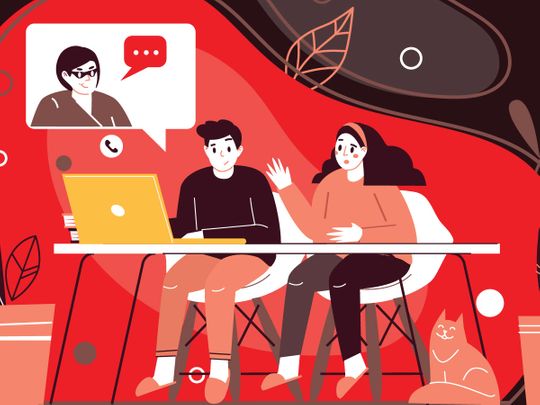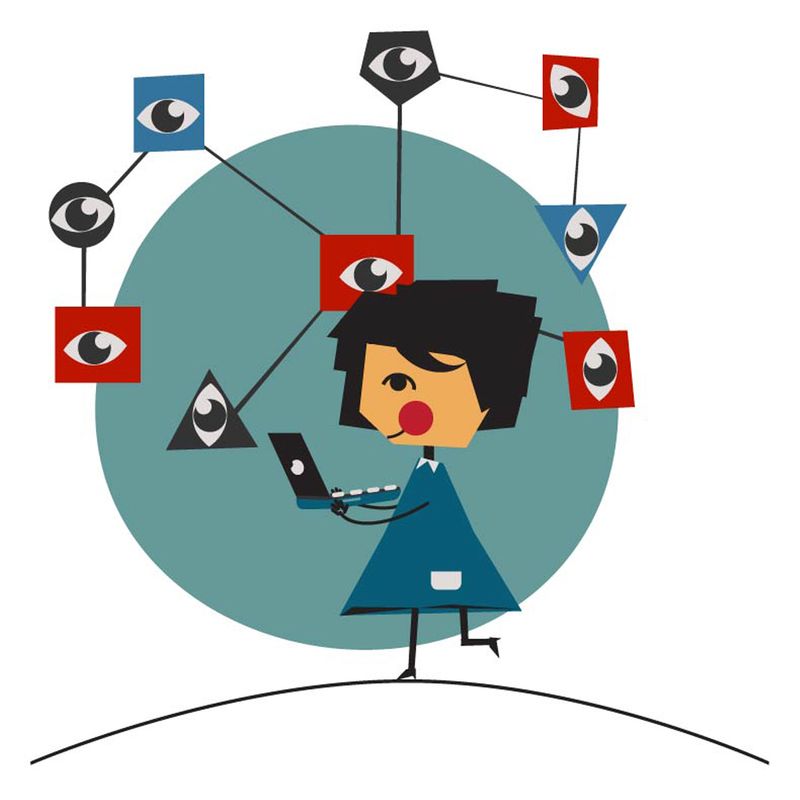
As the mother of a 5 and 1-year-old, the subject of screen time and online safety seemed like a far-off problem for Dubai-based British expat, Mary Samways.
Her children spent the majority of their time playing with their “Dubai family” – a diverse mix of 7 sets of parents and children aged 0-10 years, who met because of a joint interest in nature-based childhood activities.
From exploring the natural world, to arts, crafts and gardening, the children enjoyed a blissfully screen-free existence. None of the kids had their own electronic device, apart from one 9-year-old girl, who knew to use her phone for calling her parents and nothing else.
But then one day everything changed.

“Three of the children – one 7-year-old boy and two 9-year-old girls - locked themselves in the bathroom and, when we discovered them, said they had been playing on the phone,” recalls Mary. “They showed us ‘the game’ they had been playing, which was of one of them lying on top of the other one and making groaning noises. It was obvious that they didn’t consciously know what it meant, but the video footage they had taken of it with the phone was grotesque.”
Unknown to Mary, one of the videos of this ‘game’ was uploaded to YouTube by one of the girls. By the time this was discovered and the video taken down a few hours later, it had already been viewed by hundreds of people online.
For the parents of the children involved in the video, “the sky fell down,” says Mary, “they were “heartbroken”. Although no-one came to any direct harm as a result of this incident, the group completely dissolved and the friendships became divided, says Mary. “Each parent experienced a different trauma because of it. It showed how easily and quickly wildfire can be created online.”
How COVID is fueling online child abuse
Mary’s experience is just one example of how easily technology and the internet can put children in danger – even when there’s no online predator directly involved.
But the pandemic has created a situation in which more kids are stuck at home and bored, and online predators are exploiting it – often while the children’s parents are just a few footsteps away in the same house.
The Internet Watch Foundation (IWF) - a UK charity responsible for finding and removing images of child abuse from the internet - noted a monthly record of more than 15,000 reports of online child abuse in September 2020 alone, up 5,000 on the same month the previous year, and received a 50% surge in reports to its hotline over the 2020 lockdown period.
Online grooming is fuelling this growth in abuse. It’s also changing what that abuse looks like - where online child abuse used to predominantly be footage taken by adults, increasingly children are being tricked, cajoled or blackmailed into taking the footage themselves. The IWF reports a dramatic 77% increase in the amount of “self-generated” abuse material as more children, and more criminals, spend longer online in 2020.
What is online grooming?
“Grooming is the establishment of contact, and the building of trust in a relationship, to the point where a young person feels ‘okay’ with sharing inappropriate images, details or videos, with the other party,” says Barry Lee Cummings, CEO of Beat The Cyber Bully, which advocates for parental awareness of digital safety issues in the UAE. “At which point demands for money can be made (sextortion) or demands for more content can be made (extortion), otherwise the perpetrator threatens to share what they already have with family members, friends, or the wider internet. And in some extreme cases the perpetrator is looking to meet in real life, and this is where we see child trafficking come to the fore.”
With kids spending so much more time at home in front of a screen during the pandemic, predators are exploiting the functionalities in websites and apps that children frequent. Many hugely popular multi-player video games (including the likes of Roblox, Minecraft and Fortnite) and social media sites enable users to connect with and speak to people anywhere in the world, including complete strangers. The predator might pretend to be a child too, or they might ingratiate themselves with virtual gifts – like gaming currency – in return for explicit photos and videos.
What kind of sites put children at risk of online grooming?
“Social media apps like Snapchat, Instagram and TikTok that are now predominantly video-based and are built around the premise of amassing a huge audience pose a big threat, as this is the ideal environment for predators to operate in when it comes to things like grooming,” says Barry Lee Cummings. “It’s easier for them to make initial contact, develop the relationship privately via direct messages, and then look to solicit inappropriate content, money, or an offline relationship.
“Having said that, one of the most devastating cases of grooming to unfold did so on a gaming platform in full view of the young boy’s parents,” he adds, referring to the case of British 14-year-old Breck Bednar, who was groomed through an online gaming platform, convinced to meet up in real life, and then was tragically murdered.

How common is online grooming?
The situation in the UAE is no different to other parts of the world because geography is not an issue for online predators, says Cummings. “In some of the examples I have come across the predator was not based in the UAE but was targeting young vulnerable people here, just like any other part of the world where young people have access to the internet.”
Pre-COVID Cummings would deliver in-person awareness sessions at schools, and he says he would often be approached by young people who had watched one of his workshops and wanted advice: “often because they had shared inappropriate videos or images with effectively a stranger they thought was someone they could trust. It’s something I would come across in 65% of schools I would present at.”
Many of the examples were sextortion-related, he says: “demands for money were made once the first images or videos were sent, under threat of those images or videos being shared with family, friends, school or posted on social media platforms.”
However, many grooming interactions are not reported, says Dr Thoraiya Kanafani, clinical psychologist and co-owner at the Human Relations Institute and Clinics in Dubai, either out of fear of parental reactions, or out of shame and embarrassment. “But if we were to take the same estimates from around the world and apply it to the UAE, I would say that the problem of grooming is a lot more common than we think or would care to fathom," continues Dr Kanafani.
Who is susceptible to being groomed?
Tweens and teens seem to be most susceptible to online grooming, “but that’s a very broad statement, as you have children and young people the same age, but at vastly different points developmentally,” says Cummings. “Both boys and girls are affected by grooming, and it tends to be those that are not getting attention elsewhere in their lives (real or perceived) or in some cases, those seeking out risk, as teens are wired to do.”
Usually those between the ages of 12 to 15 are the most susceptible to online grooming or predators, says Dr Kanafani: “because they are naive to the realities of the online world and are usually not educated about its dangers.”
For those children who are educated and not naive to the online world, they often engage in more complex and interactive Internet use, which may in turn put them at greater risk, she adds.
“Furthermore, young teenagers are much easier to manipulate as they enter their individuation phase, since this phase is characteristic of separating from their parents even more than they already may be. “Those who are submissive in nature, have low self-esteem, do not have many friends, have experienced physical or sexual abuse as children, have an estranged relationship with their parents, and are female in gender tend to be the most vulnerable. These children tend to feel isolated and shunned from others, therefore they attach quite quickly to predators who are charming and show them attention online.”
- Being secretive about spending time online
- Having new things they can't explain; having more money not given by parents
- Getting a lot of messages from a person they only know online
- Planning to meet or talking about an older individual they know online
- Spending more time alone
- Avoiding talking to parents about their day or what they are doing (more than usual as teenagers may do this anyway)
- Spending less time with friends they have and more time online
Barry Lee Cummings from Beat The Cyber Bully adds:
- Changes in eating habits, either from a healthy appetite to not eating or potentially a sudden increase in how much they are eating
- Your child was online all the time and now suddenly seems to be disinterested or were never that interested and now can’t seem to put their phone down
- They used to be happy being on their device in the living room, now they are constantly in their room and distant
- They are just unwilling to discuss their internet use at all
- Exhibiting mood swings and volatile behaviour
- A sudden introduction of inappropriate sexual language
- Exhibiting sexualized behaviour - sometimes a change in the way they dress
- They display suspicious behaviour when you come into a room, switching off the monitor or changing screens quickly on their laptop or phone.
What parents can do to protect children online
According to research by Mobily eSports, 50% of parents believe their children speak to strangers online as often as two to three times a week, while 33% of parents are unaware of who their child is playing video games with.
Statistics like this are deeply concerning for digital safety experts, who are keen to point out that just as you wouldn’t let your child run around the mall unsupervised or with complete strangers, nor should you allow them to mix with people you don’t know online.
“We all know the traditional advice that children should never be left unsupervised, especially at a young age,” writes the advice on the UAE’s Digital Wellbeing Council website, established in January 2021 to help parents protect children online, amongst other things. “Leaving children alone AND with digital devices presents a whole new set of serious risks.”
11 Ways to monitor your child's online behaviour
Often digital devices are used as a semi ‘babysitting’ service by busy parents – keeping kids safely in one place and out of trouble. But unless parents are actively engaged in their children’s digital worlds then screen time can have just as many, unseen dangers.
“Across all apps or platforms, parents need to get up to speed with the parental controls or privacy controls associated with each platform. This is just the base level of protection that should be in place,” says Barry Lee Cummings. “Then as parents, we need to also understand that when a platform has a 13 year old recommendation for use, it should be abided by. Sometimes even 13 is too young, but if you allow your 8 or 9 year old onto Instagram or Snapchat or TikTok, they are potentially going to be exposed to people and imagery they don’t know how to deal with.”

If you want to monitor everything your kids are doing, then you will most likely want to go with an Android device, says Lance Spitzner, SANS Director of Security Awareness, as it allows you to monitor much more. On Apple iOS devices it can be much more limited.
Examples of software you can get for monitoring / controlling kids devices include:
o Teen Safe
o My Mobile Watchdog
o Web Watcher
o Circle
o Boomerang
o Nischint
These allow you to remotely monitor and control where your children are going online and for how long, says Barry Cummings. However they tend to be paid for, and require that you install the software on your child’s device, which can slow the device down
INSTALL MONITORING SOFTWARE FROM THE START
Monitoring software works across age ranges, says Barry Lee Cummings, “and actually the younger they get online the sooner the tools and parameters should be in place. Also the younger they are, the more, just a part of the digital experience, having monitoring software becomes.”
But communication with your child is still key, he adds: “Ideally we should be speaking to our children about what and why we are installing the software, as open communication is really the key to this entire situation.”
PICK STRONG PASSWORDS
Some of the parental-control options, once installed, are hidden and not removable by the child but even those that are, usually require some sort of password protection, “so coming up with codes or passwords your kids don’t know and can’t guess is imperative,” says Cummings. “We recommend using something like www.Lastpass.com for this.”
REMOVE THE SEARCH BAR ON YOUTUBE
Restricting children’s ability to search on YouTube limits what they can get access to, says Cummings. “To do this you initiate Safe Search with Restricted mode; you turn it on in the drop down menu from your account icon. This is easy to turn on and off, but if you want to lock restricted mode for that browser, you sign into your Google account using your username and password, and then sign out again, and YouTube restricted mode can’t be turned off until you log in and turn it off on that browser.”
GET YOUTUBE KIDS
“Within YouTube kids you can effectively turn off the search bar in settings as a toggle button. We recommend parents do this and subscribe them to certain channels, so they don’t need to go searching. It’s still not 100% foolproof though, which is why it’s so important for parents to be actively involved, and do additional monitoring.
INSTALL AD BLOCKERS
Install ad blockers on your child’s browsers, says Cummings: “This will not allow tempting ads to pop up during their experience,” so they aren’t expose to potentially unsafe material or enticed to click on them.
CHECK THE CONTENT OF YOUR CHILD’S GAME
The "Sannif" platform (www.sannif.ae), presented by the Telecommunications Regulation Authority (TRA) and the Digital Government of the UAE, enables parents to learn about e-games and their nature and content before introducing them to their children.
CONTACT THE DIGITAL WELLBEING SUPPORT LINE
The UAE’s "Digital Wellbeing Knowledge Platform" (www.digitalwellbeing.ae) is a comprehensive interactive web portal that includes awareness content for parents, to raise their awareness of digital safety, common mistakes, and how to protect themselves and their children. If you have questions about your child’s online safety in the UAE, contact the Digital Wellbeing Support Line. The consultants will listen to your issue and help you find the best solution. Call 80091.
DOWNLOAD COBABBLE
Technology is developing every day, so it can be hard to stay abreast of the latest online game or app that you may need to watch out for as a parent. The Beat The Cyber Bully app is aimed at UAE parents, and keeps you updated with all of the latest digital threats and safety technology as and when it is released - more info at https://btcb.cobabble.ae.
The inconvenient truth
As children get older it becomes increasingly hard to control their online movements with technology. “At the end of the day, you can’t outsource parenting,” says Lance Spitzner, SANS Director of Security Awareness, “no technology is going to protect your kids against all dangers online.”
Technology is constantly changing, and the way in which kids use that technology is constantly changing. “I would be less concerned about what specific apps kids are using, and more concerned about whether parents are talking to their kids and asking them to show the parents what they are doing online.”
Ultimately, the best defence is to talk to and educate your kids about good behaviour online, and to give them guidelines and values, says Spitzer. “These guidelines and values are actually very similar to the way in which you want them to behave in the real world. You want to be sure you have a two-way dialogue between you and your children all the time. A great way to start the conversation is to put them in the role of the teacher and ask them to show and teach you what apps and games they use online and how they work.”
• For child-related cybercrimes, you can also report through the Ministry of Interior Child Protection Center channels:
- Call the Hemayati Child Hotline through 116111
- Hemayati app on apple store or google play store
- E-mail childprotection@moi-cpc.gov.ae
It's certainly easier said than done. But who ever said parenting was easy?
For Mary Samways, her own negative experience with the online world when her children were still so young brought home for her the pervasive danger that it poses for all kids. “My girls are now 11yr and 7yr and still don’t own their own devices,” she says. “Because I know that it is a floodgate - as soon as they do have their own device, my parenting controls need to jump up a notch and I’m not sure I’m ready yet! It’s easier for now, to keep the phone out of their hands. I want to see how they behave off line - in real space - in real interactions with their friends and us as parents and adults in general, before it happens in cyber space, online.”
Clinical psychologist Tanya Dharamshi from the Priory advises, “Create ‘media-free’ zones in the house like bedrooms. Always ensure they are not ‘locked-away’ on their devices but use them in the presence of others so you can subtly monitor what sites they’re visiting.”
HAVE DEVICE-FREE TIME BEFORE BED
“Introduce time limits on screen time, require parental approval for app downloads and ensure ‘device-free’ time throughout the day and at least 60 minutes prior to bedtime,” says Dharamshi.
NEVER LEAVE PHONES CHARGING IN THE BEDROOM
“The temptation to use during the night or as soon as they wake up is too great,” says Dharamshi.
MAKE CLEAR THAT ONLINE RULES ARE THE SAME AS OFFLINE RULES
Shahed Al Hindi, Human Rights Public Policy Manager, MENA at Facebook says: “If it's not something you want others to do to you, don't do it to others. Just as you might tell your child to look both ways before crossing the street or to wear a helmet while riding their bike, teach them to think before they share online.”
TRY TO BE A GOOD ROLE MODEL
The adage that children will "do as you do, not as you say" is as true online as it is offline says Shahed Al Hindi of Facebook. “If you set time restrictions on when your child can use social media or be online (ex: no texting after 10:00 PM), follow the same rules.”
ENGAGE EARLY
Research shows that many children as young as six have access to smartphones or tablets, says Al Hindi. “Just as you lay the foundation for dialogue and conversation offline with your children early, you should lay that foundation early online. Talk to them about technology, before they are on social media. If your teen is on Facebook, consider friending them.”
IDENTIFY AND SEIZE KEY MOMENTS
For example, when your child gets their first mobile phone, it's a good time to set ground rules, says Al Hindi. “When your child is old enough to join Facebook and other social media, it's a good time to talk about safe sharing. When your child gets a driver's license, it's a good time to discuss the importance of not texting and driving.”
TRUST YOURSELF
Shahed Al Hindi, Human Rights Public Policy Manager, MENA at Facebook says: “Typically, you can adopt the same parenting style for your child's online activities as you do for their offline activities. If you find that your child responds best to a negotiated agreement, create a contract that you can both sign. Or, maybe your child just needs to know the basic rules.”
ASK YOUR CHILD TO TEACH YOU
Not on Facebook, Instagram or Tiktok? Or, maybe you're interested in trying a streaming music service? If your children are already familiar with these apps and sites, they can be an excellent resource, says Al Hindi. “The conversation can also serve as an opportunity to talk about issues of safety, privacy and security. For example, you can ask them questions about privacy settings as you set up your own Facebook account. And, as most parents know all too well, your child will likely appreciate the opportunity to teach you.”
Legal Action against Cybercrimes in the UAE
In the UAE, the below crimes are illegal under Combating Cyber Crime Law no. (5) of 2012.
Article 18: Acquiring child abuse material
Article 19: Using technology to encourage someone to engage in explicit behaviour.
Punishment is harsher if the victim is under 18 years of age.
Laws Protecting Children’s Safety in the UAE
The UAE’s Federal Law No. 3 of 2016 concerning child rights, also known as Wadeema's Law protects children against all forms of negligence, exploitation, physical and psychological abuses. This includes harm to children in the digital world.
• Article 42 of Wadeema’s Law emphasizes mandatory reporting:
• Clause 1: Every person shall notify the child protection specialist or child protection units in case of anything that threatens the child's physical, psychological, moral or mental integrity or health.
• Clause 2: The notification shall be mandatory for the educators, physicians, social specialists or others entrusted with the protection, care or education of the child.
• Article 60: Whoever violates the provisions of Clause 2 of Article (11), Articles (28), (34), (35) or Clause 2 of Article (42) of this Law shall be punished by imprisonment or a fine not less than Dh5,000 (five thousand).
• Article 64 emphasizes that if telecommunication authorities don’t report child sexual abuse material online, they are also liable to a penalty between 100,000-1,000,000AED
• Article 65: explains that the creation, distribution, filming and sexual exploitation of children and is punishable by a minimum 10 years imprisonment.
• Article 66 explains that having, downloading, sending, uploading child abuse material through the internet is punishable by a minimum 1 year imprisonment and a fine between AED 100,000 and AED 400,000
• Article 70 explains that the claim of the perpetrator being not aware of the age of the victim may not be pleaded.









